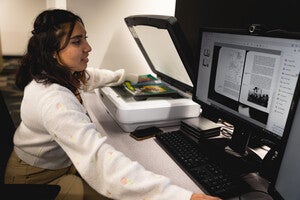ASU faculty and instructors looking to help students connect to their course materials at no cost can find specialized support at the ASU Library. By working with Course Resource Services (CRS) and using a tool called the Library Resource Organizer integrated within Canvas, instructors can save students an average of $237 per course. Collaborating with librarians, professionals and student workers, the CRS team is committed to expanding access to education, one course at a time.

“We always knew that the library helped save students money, but we didn’t know how much,” said Anali Maughan Perry, scholarly communication librarian and division head for Open Science and Scholarly Communication, which includes Course Resource Services. “This past year, we analyzed a representative sample of courses that we provided materials for. What we found is when you add up the cost a student would pay for the resources that the library provides to them for free, it averages out to about $237 per course. Apply that cost to each student and it makes a huge difference - we saved students over $6 million last fall semester alone!”
If the library doesn’t already own the content, CRS will research the possibility of purchasing ebooks and streaming services and when available, provides direct and persistent links to library resources and connects students to articles. Terri Hlava, who teaches Justice Studies and Disability Studies courses in the School of Social Transformation, appreciates how efficient the service is because it keeps track of particular resources and makes them easier to update.
“We love working with the Library Resource Organizer team,” said Hlava. “The library maintains all of the course links so that the material is always available for our students. And they make sure that the material is as accessible as possible so that students who use screen readers can navigate the content easily and efficiently.”
The feedback Hlava receives from students is a strong indicator of how the tool improves engagement within classes.
“Students tell us how much they like having all of the material gathered into the organizer tool,” said Hlava. “The librarians set up the material according to the syllabus, putting items together by module, and students can just click into any part of the course to find the material they need all in one convenient place — ready to use!”
In addition to reducing costs, CRS reviews course content to ensure it aligns with ASU accessibility standards such as providing captions and transcripts for library videos.
“We make an effort to give faculty peace of mind knowing that anything provided by our team has been evaluated for copyright and accessibility considerations,” said Chris Thuenen, course resource services manager. “We work with liaison librarians and instructors to find licenses and open resources to help alleviate cost burdens where it is possible.”
The team includes student workers who see the real-time impact of providing accessible information for fellow students.

“This department may be small but we get a lot done through dedication and consistent teamwork,” said Beatriz Ayala, a student worker on the team, “As technology continues to evolve, we have the potential to expand ASU library resources beyond a traditional library catalog.”
Student worker Becky Salazar emphasizes the team’s ability to adapt to new challenges and technology.
“We aim to aid and improve their experience when navigating a plethora of library resources and hope to establish a well-founded connection with ASU affiliates,” said Salazar. “We expose ASU staff, faculty and students to a wide variety of knowledge, and contribute to the reimagining of education as technology continues to evolve.”
As the fall semester gets underway, CRS hopes to expand access and reach more students this year.
“We are always happy to consult on course resource support,” said Sam Mijal, course resource services coordinator. “If instructors want to work with us, start by visiting our website, looking at our library guide and connecting with the team.”
During the full 2022 year, CRS saved ASU students a little over $13 million dollars.
“This is only a small percentage of the courses taught at ASU,” added Perry. “Even though there are always things the library won’t be able to provide, we love to work with instructors to find alternatives, or even better, discover an open educational resource to use instead. We envision a future where the majority of courses are no-cost or low-cost for all ASU students, removing hurdles and helping students succeed.”